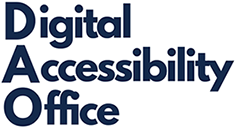Microsoft Word Accessibility
This page is designed as a companion for our Document Remediation Part 1 – Word and PowerPoint training. Check out our training calendar for our next session where we will cover these topics in detail.
Microsoft has a wonderful page dedicated to making your Word documents accessible. This site can be a great place to go after you take our training for a foundation.
Checklist for Microsoft Word Remediation
- Content – Speak to your audience and use Plain Language
- Structure – Style text correctly using default headings and lists
- Structure – Use paragraph spacing and layout tools instead of multiple line returns or spaces.
- Fonts – Use simple and easy to read fonts
- Images – Add appropriate alt text or mark as decorative
- Images – Do not change image settings for text to wrap around it. Leave at default “in-line with text” so graphics maintain in the proper reading order.
- Tables – include column and row headers, and do not split/merge cells
- Tables – Set text wrapping to none in table properties
- Hyperlinks – Use descriptive concise text for hyperlinks that makes sense out of context
- TOC – Create a table of contents for long documents.
- Document Properties
- Title
- Subject
- Author
- Advanced – Language of document
- Auto Check – Run Word’s accessibility checker and fix issues
- Color Contrast – Check color contrast of fonts vs background colors
- Export to accessible PDF
Document Structure
Microsoft Word has built-in tools to structure your document in an accessible way. Ensure you are always using these tools when formatting the layout of your documents.
Headings
Headings are part of the semantic structure of your document. Accurate headings ensure the document has a strong meaningful structure. Users of assistive technology will often use headings for navigation.
Headings break content into sections and subsections. They are also used to create a table of contents.
- Heading 1 for the title of the document
- Heading 2 for major section titles
- Heading 3-6 for subsections
Microsoft has a page with instructions for adding headings in Word.
Heading 1 vs Title?
Heading 1 wins! The Title style converts to a basic paragraph in PDFs instead of H1.
Lists
Lists break content into smaller/easier to digest pieces. Use lists whenever possible!
Ensure you are using Word’s built-in bulleted list, or Numbered list options and not just breaking content into separate lines.
Microsoft has a page with instructions for adding lists in Word.
Paragraph Spacing and Layout Tools
Hitting enter or tabbing many times to move content can cause some problems with screen readers. These problems are more complicated when exporting to PDF.
Use Word’s built in Paragraph Spacing and Layout Tools for additional spacing, and layout designs.
Text
If you are unsure of the most accessible fonts to use, then sticking with the program’s default is always a safe bet.
Fonts
UNC’s Typography website has several official fonts for you to choose from. When making digital content make sure you use the “Recommended University Web Fonts.”
Color Contrast
Always check the contrast between your font and the background color. Several color contrast checkers out there that can make this process easier. Ensure you are passing A and AA criteria. The AAA criteria is not required.
Inserted Items
Images
Ensure all images have appropriate alt text which is the text equivalent of the image’s purpose. Detailed images such as graphs may need to have longer descriptions elsewhere in the body of the document. Microsoft has instructions on how to add alternative text in Word.
Alt Text Tips
Do:
- Be accurate and concise
- Keep it to less than 140 characters (think tweets)
- Mark decorative images as decorative in the alt text window
Do NOT:
- Be redundant
- Include words like “image” in your alt text
Also: avoid text within an image.
- If you have text in an image, duplicate it within the alt text
- Logos are an exception to “no text within an image”
Tables
Note: Tables should only be used for tabular data and not layout/design. Tabular data is when the relationship between the rows and columns is important.
Tables are complicated items for assistive technology even when built correctly. Ensuring your tables are accessible will help reduce some common issues.
Microsoft has some basic instructions on Creating Accessible Tables in Word.
Document Properties
Document properties give important information to both the user and the assistive technology they use. Screen readers rely on these properties to know which language it should read the document in.
Required Document Properties for Accessibility:
- Title – Concise and descriptive title
- Subject – Very short description of the document’s subject
- Author – best practice is to put the office that owns the document rather than the person who created it
Microsoft has some instructions on accessing the document properties in Word.
Built -in Accessibility Checker
Word’s Built-in Accessibility Checker is great for catching some basic accessibility issues. To learn more about how to use the accessibility checker, check out Microsoft Office’s tutorial.
Please note that even if you get a fully cleared check, that does not mean your document is fully accessible. Manual checks on things like the overall Document Structure still needs to be done.
